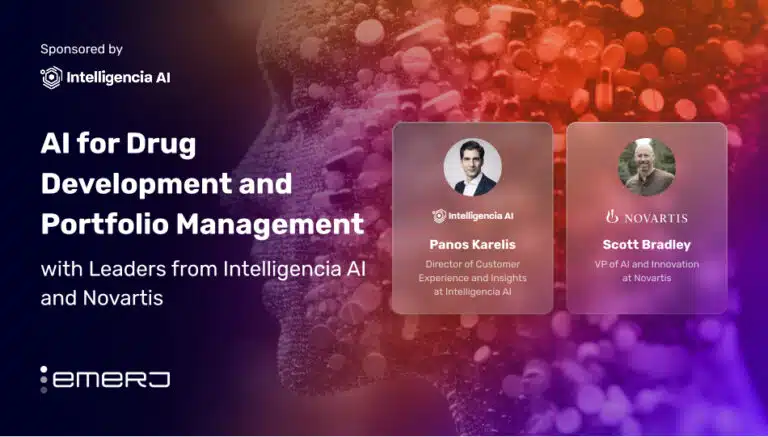This interview analysis is sponsored by Arkestro and was written, edited, and published in alignment with our Emerj sponsored content guidelines. Learn more about our thought leadership and content creation services on our Emerj Media Services page.
The COVID-19 pandemic exposed significant limitations in the pre-pandemic supply chain systems of the pharmaceutical industry, which were primarily designed around the just-in-time model. This model focused on keeping inventory low to free up capital and proved fragile in the face of sudden disruptions.
Recent research supported by the National Library of Medicine takes a deeper look into available drugs offered by hospital management systems throughout the pandemic. It finds the pandemic triggered unprecedented shifts in demand and introduced new uncertainties in the production and distribution of essential medications.
For instance, lockdowns, understaffing, and travel and export bans disrupted the production and shipping of pharmaceuticals globally, leading to shortages of critical medical products.
The pandemic also highlighted the need for more resilient and responsive supply chains, particularly through the adoption of predictive analytics and machine learning. Research Paper published by Taibah University highlights the critical role of these technologies in enhancing the resilience and agility of pharmaceutical supply chains post-COVID-19.
By leveraging real-time monitoring, anomaly detection, and risk impact assessment, pharmaceutical companies can predict and mitigate potential disruptions, such as demand volatility and supply chain bottlenecks. This approach enables adaptive decision-making, ensuring that critical operations remain uninterrupted and essential medications are always available, thereby addressing the vulnerabilities exposed by the pandemic.
Emerj Senior Editor Matthew DeMello recently sat down with Vickram Srivastava, Head of Supply Chain Management at SUN Pharma, and William Seagrave, SVP of Product Solutions at Arkestro, to talk about the future of business and supply chain processes, focusing on how technology, especially AI and automation, will drive transformation, improve collaboration, and enhance visibility across the value chain.
Sun Pharmaceutical Industries Ltd. (Sun Pharma) is a specialty pharmaceutical company that develops, manufactures, and markets a wide range of pharmaceutical formulations, including generics, branded generics, and complex formulations, across various therapeutic areas globally. Arkestro is a tech company that provides clients with a predictive orchestration platform that leverages machine learning and data science to optimize procurement processes.
Their unique experiences enriched the conversation by blending strategic thinking with practical solutions, offering a comprehensive view of navigating a complex, unpredictable global landscape.
We bring you two key insights from their conversation:
- Embrace AI as a support tool for enhanced efficiency: Leverage AI as a tool to support and streamline business processes without replacing human judgment, train teams to apply AI insights for decisions, and build strategic vendor partnerships for enhanced collaboration and operational visibility.
- Adopt just-in-case strategies for risk management: Move beyond traditional just-in-time inventory practices to incorporate just-in-case strategies that prepare businesses for rare but impactful events, such as pandemics and natural disasters.
Guest: Vickram Srivastava, Head of Supply Chain Management, SUN Pharma
Expertise: Supply/Demand Planning, Strategic Sourcing, Vendor Development
Brief Recognition: Vickram Srivastava, Head of Supply Chain Management at SUN Pharma, leads supply chain operations for the North America region, enabling over $2 billion in sales. His responsibilities span planning, warehouse management, logistics, distribution, and procurement while managing budgets to ensure seamless business operations. With prior experience at IPCA Laboratories, Zydus Group, and Mylan, Vickram brings extensive expertise to his role. He holds a Master’s degree in Global Logistics and Supply Chain from SP Jain School of Global Management, India.
Guest: William Seagrave, SVP of Product Solutions, Arkestro
Expertise: Supply Chain, Procurement, Sales Execution
Brief Recognition: William Seagrave is the SVP of Product Solutions at Arkestro. In his over 30-year career, he has launched new products, creating new revenue growth exceeding $10 billion in annual sales. He has multi-industry experience with product lines, including supply chain, manufacturing, procurement, financial services, biotechnology, enterprise applications, big data analytics, networks, and others.
Adopt Just-In-Case Strategies for Risk Management
Vickram opens the conversation by talking about the importance of moving beyond just analyzing spending data and adopting a broader perspective that leverages big data to make better decisions. He refers to building resilience in procurement, which is the ability to adapt and maintain stability amid disruptions.
He also highlights that AI plays a crucial role in enhancing visibility and providing deeper insights not only into the direct suppliers (the primary vendors) but also into secondary (tier two) and tertiary (tier three) suppliers. This approach allows companies to monitor and understand their entire supply chain more comprehensively.
He then talks about the need to go beyond traditional “just-in-time” inventory practices and prepare for unexpected disruptions with “just-in-case” strategies. While JIT ensures smooth operations by maintaining the right amount of inventory, companies must also plan for rare but impactful events (e.g., pandemics, wars, natural disasters) to build resilience and maintain supply chain stability during crises.
William, in response, discusses how the COVID-19 pandemic revealed the limitations of pre-pandemic supply chain systems, which were designed for a “just-in-time” model focused on keeping inventory low and freeing up capital.
He points out that, until then, software and technology in the supply chain industry had not been built to address resilience and automated decision-making. Systems were optimized for efficiency — like faster catalog sorting or contract management—but not for the ability to adapt and respond to disruptions.
The pandemic highlighted the need for better analytics and planning to manage inventory levels and ensure that backup vendors are ready in case primary suppliers fail, especially in critical industries like pharmaceuticals.
“So there’s all kinds of constructs that now come into play that, to your earlier point, are beyond cost. Although, what’s interesting in the pharma groups that is not in the other industries: If the other industries are more concerned with cost and risk and all of that, pharmaceuticals are less interested in the cost. That’s always important.
What is more interesting is expediting the time-to-market, fast time-to-change. Because if I can get that drug out the door one month earlier – six months earlier, one year earlier – then I’m making hundreds of millions and billions earlier than if I can take the time. That’s a place that procurement can actually step up and address by dealing with these issues of resilience and continuity.”
–William Seagrave, SVP of Product Solutions, Arkestro
William also notes that unforeseen political events like the recent US elections can impact the supply chain, and to stay ahead, teams need technology that empowers them to respond effectively and adapt to a constantly changing world.
Vickram agrees with Bill’s points and emphasizes the unpredictability of the world, highlighting that events such as elections, wars, terrorist attacks, or natural disasters like volcanic eruptions can cause significant disruptions. He explains that today’s global supply and value chains are more complex, interconnected, and vulnerable than ever, making them prone to various disruptions.
He stresses the importance of integrating checks and balances into supply chains and using tools and technology to make quick, effective decisions. The ultimate goal is to ensure that supply chains are resilient and able to maintain business continuity while driving business value.
Embrace AI as a Support Tool for Enhanced Efficiency
Vickram discusses the role of AI in the professional world, clarifying that it won’t completely replace human workers or functions. He believes AI will be a tool that enhances and supports work, making tasks more efficient, similar to how computers in the 1980s transformed business operations without replacing people.
However, he emphasizes that human input will still be necessary, particularly in decision-making. While AI will facilitate and improve the process of using information to make choices, the final decision-making will continue to rely on human judgment. He also highlights the need to prepare for this shift by training and investing in the next generation to use these technologies effectively.
William, on the other hand, notes that AI has varied definitions. For instance, user interfaces like ChatGPT are easy to integrate for simple data queries. However, the true potential of AI lies in machine learning models, which are designed to process vast amounts of data and can be configured by users to achieve specific outcomes. Unlike a simple question-answer interaction, a machine learning model performs comprehensive data analysis to generate insights and outcomes.
He foresees a future where businesses are managed by autonomous systems, with people focusing on setting rules and outcomes while the systems handle operations. He likens this shift to the evolution of CRM from on-premise to cloud-based solutions.
Traditional procurement and manual processes will be replaced by automated, strategic systems, creating efficient, seamless business operations driven by advanced computing.
Vickram builds on Bill’s ideas, emphasizing the transformative impact of technology on business and supply chain processes, particularly procurement. He highlights the shift towards viewing vendors not just as suppliers but as strategic business partners and collaborators.
Vickram goes on to stress the importance of tools that enhance visibility and facilitate “conscious collaboration” across the entire value chain, moving beyond simple coordination or cooperation. He believes these tools will be crucial for fostering deeper collaboration and more efficient operations in the future.

















